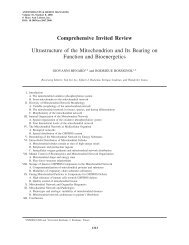MiPsummer Programme pdf - Mitochondrial Physiology Society
MiPsummer Programme pdf - Mitochondrial Physiology Society
MiPsummer Programme pdf - Mitochondrial Physiology Society
You also want an ePaper? Increase the reach of your titles
YUMPU automatically turns print PDFs into web optimized ePapers that Google loves.
81<br />
Abstract # 49<br />
<strong>Mitochondrial</strong> toxicity of Metformin and Phenformin assessed by respirometry of human<br />
peripheral blood cells<br />
S. Piel, E. Elmér, J. Ehinger, S. Morota, A. Shahini, MJ. Hansson<br />
<strong>Mitochondrial</strong> Pathophysiology Unit, Lund University & NeuroVive Pharmaceutical AB, Lund,<br />
Sweden.<br />
Purpose: Metformin and Phenformin are anti-diabetic drugs. Phenformin has been banned from the<br />
market due to the high incidence of lactic acidosis (LA). 1 Metformin is generally considered as safe<br />
but the development of LA has been reported in rare cases. 2 In both cases, LA is thought to be<br />
linked to drug-induced mitochondrial dysfunction in the liver and other tissues. 1 Using highresolution<br />
respirometry it was investigated whether Metformin- and Phenformin-induced<br />
mitochondrial toxicity can be detected in human peripheral blood cells.<br />
Methods: Thrombocytes were isolated according to Sjövall et al 3 and white blood cells were<br />
isolated by Ficoll gradient centrifugation 4 . The integrated function of mitochondria in both intact<br />
and permeabilized blood cells was studied using high-resolution respirometry. The cells were<br />
treated with a wide concentration range of Metformin, Phenformin or vehicle to assess direct effects<br />
by the compounds on respiration. Thereto the time-dependent effect of Metformin on endogenous<br />
respiration in intact thrombocytes was followed for 60 minutes. In permeabilized cells, a multiple<br />
substrate-uncoupler-inhibitor-titration (SUIT) protocol was used in order to determine maximal<br />
respiratory capacities and the site of toxicity of Metformin and Phenformin.<br />
Results: Intact thrombocytes showed a decreasing routine respiration and maximal electron transfer<br />
system (ETS) capacity with increasing doses of Metformin compared to controls. In permeabilized<br />
thrombocytes, Metformin and Phenformin induced a dose-dependent reduction of maximal<br />
oxidative phosphorylation and uncoupled ETS capacity predominantly through inhibition of<br />
complex I. Lower concentrations of the drugs were required to induce respiratory inhibition in<br />
permeabilized cells compared to intact, but the toxic effect in intact cells developed over time.<br />
Although a qualitatively similar toxic effect was seen for both drug treatments, the cells were more<br />
sensitive to treatment with Phenformin than Metformin when using the same concentrations. The<br />
toxic effect of Metformin was also similar in permeabilized white blood cells.<br />
Conclusion: Metformin and Phenformin have a direct toxic effect on mitochondrial function in<br />
human peripheral blood cells. The reduction of respiration is predominantly mediated through a<br />
dose-dependent inhibition of complex I. Respirometry of peripheral blood cells may be a suitable<br />
assay to predict mitochondrial toxicity of drugs in humans.<br />
References:<br />
1 Dykens J. A., Jamieson J. et al. (2008). Biguanide-induced mitochondrial dysfunction yields increased lactate<br />
production and cytotoxicity of aerobically-poised HepG2 cells and human hepatocytes in vitro. Toxicol Appl<br />
Pharmacol. 233: 203-210.<br />
2 Protti A., Lecchi A. et al. (2012). Metformin overdose causes platelet mitochondrial dysfunction in humans. Critical<br />
Care. 16: R180.<br />
3 Sjövall, F., Morota, S. et al. (2010). Temporal increase of platelet mitochondrial respiration is negatively associated<br />
with clinical outcome in patients with sepsis. Critical Care. 14: R214.<br />
4 Boyum A. (1968). Isolation of mononuclear cells and granulocytes from human blood. Isolation of monuclear cells by<br />
one centrifugation, and of granulocytes by combining centrifugation and sedimentation at 1 g. Scand J Clin Lab Invest<br />
Suppl. 97:77-89.



